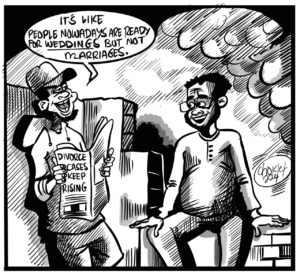Copperbelt Energy Corporation (CEC) Plc says all stakeholders must be willing to pay for any looming power tariff increment to reduce load shedding in Zambia, but only if the Cost of Service Study proves that the cost of generating power is more expensive than the existing tariff structure.
Commenting on the looming power tariff increment ahead of the release of the Cost of Service Study, CEC managing director Owen Silavwe said Zambia still required an upward adjustment in its power tariffs to address load shedding, which remained a challenge.
“If the solution has been discussed, we don’t have any other local sources so the short-term is either emergency sources or import from the region. So what that means is that depending on the price at which we import (power), it might require that all the consumers top up. If that reasonable uplift basically guarantees less hours of load shedding, I think it makes sense. All consumers [should] support that, be it mines, be it residential, be it industrial or commercial customers,” Silavwe said.
“So, as a principal, if we are going to put a solution on the table that reduces the hours of load shedding and that solutions requires additional funding, I doubt that government, alone, can put that additional funding. If the government is able to put up, well and good. All stakeholders should support as long as it results in reduced hours of load shedding, it results in helping them to have more hours of power, which basically means it helps their productivity, obviously, at the moment the load shedding has a huge cost on the economy, on the businesses.”
He, however, emphasized the need to complete the Cost of Service Study.
“The issue has been that, the cost of providing electricity, overall, has been higher than the current average tariff in the country. That has been the raging debate. Now, what people have been demanding is that can we do a Cost of Service, which is basically meant to establish what is the real cost of providing this electricity to the consumers. If we did that, then we can understand that, the cost is somewhere around this number and then it will give us a perspective as to whether the price at which the consumers are taking power is actually lower than the cost at which we are delivering this power to the consumers,” he said.
“That is the study that has, unfortunately, delayed and everybody, obviously, focused on when are we going to get this Study. Unfortunately, the new date when the study could be completed has not yet been communicated. The Cost of Service Study is critical in guiding everybody to know what is the gap, if there is any, between the current price or tariff versus the cost at which it is delivered to the consumers. That remains critical in terms of giving us information on any gap.”
And he said the study would equally help establish if there was need for the country to increase its power tariff structure.
“The comparative studies have shown that Zambia is among the lowest with the lowest tariffs in the region. But there is an association of regional regulators that carries out that study almost every year and if you look at the result, it does stick to the fact that Zambia, among the SADC countries, is among the countries with lowest tariffs. For me, that in itself does not tell you the full story. What tells you the full story is the understanding this cost of service. Look, if your tariff is the lowest, but it meets your cost of service, there is nothing wrong with that, however, if your tariff is the lowest, but it does also not meet your cost of service as a country, then you have a problem,” said Silavwe.
“If your tariff is the lowest and it meets your cost of providing the service, then you will be saying as a country that, we have a competitive tariff because it is going to encourage investment and all sorts of things. So, it needs to be put into context by doing that cost of service before making a comparison. The real assessment is that how to compare your cost of providing the service. If it is lower than the cost of providing the service, then you have a negative gap, which you need to close that should provide a sustainable service because the issue here is sustainability. So, comparative is important. But more important is understanding the cost of service provision.”












